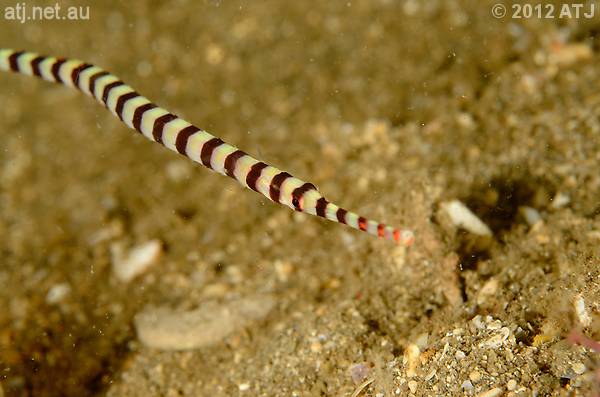
Banded pipefish, Dunckerocampus dactyliophorus, at Unusual Suspects.
This is an account of the trip I did around Komodo Island, Indonesia with friends from St George Underwater Centre Dive Club in August 2012.
The trip was on board the Pa Siren, one of the boats in the Siren Fleet from Worldwide Dive and Sail. The boat was built for sailing in Palau but because its initial voyages were in Indonesia it was initially called "Pa Siren" as "Palau Siren" was considered poor form for a boat in Indonesian waters. "lau" was added to the signage on the boat when it went to Palau.
The boat itself, as with all the Siren fleet, it quite luxurious. The cabins were very comfortable as were salon and dining area on the dive deck. The dive deck was spacious with set areas for each guest. The boat was also equipped with nitrox which increased no decompression dive times, especially on some of the deeper dives.
We met the boat in Bima, a port near the eastern end of the island of Sumbawa in Indonesia. After settling in, we sailed north in Bima Bay towards the Flores Sea for around 6 kilometres. We stopped close to the entrance of the bay for our first dive of the trip at a site called Unusual Suspects. This was a check dive so we can check our gear, weights, buoyancy, etc. It was a muck dive with lots to see and was a lot of fun and whet our appetites for what was to come on the rest of the trip. Dive details

Banded pipefish, Dunckerocampus dactyliophorus, at Unusual Suspects.
After the dive we had drinks and dinner and shortly after dinner the boat sailed for Sangeang Island.
Sangeang Island is located in the Flores Sea north-east of Sumbawa. It is an active volcano complex with two peaks. It last erupted in 1988 and the sands around the island are black which made for an interesting background to the dives.
Our first dive for the day was at a site called Techno Reef. The dive was mostly over black sands from the volcano with coral bommies spaced out over the sand. We saw many interesting things, including an ornate ghost pipefish, leaf scorpionfish, mantis shrimp and many nudibranchs. Dive details
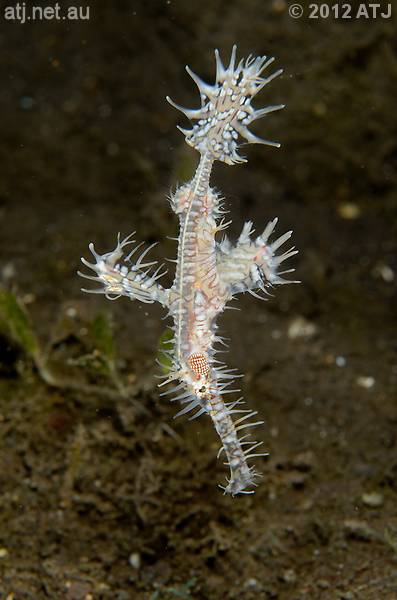
Ornate ghost pipefish, Solenostomus paradoxus, at Techno Reef.
After the dive, we sailed a short way around Sangeang Island to the second site for the day, The Estuary. As the name suggests the site was near the mouth of a river. Like the previous site, it was on black sand, although this time there was a lot more reef. The highlight of the dive was a sea fan with 3 pygmy seahorses. We also saw lots of nudibranchs. Dive details
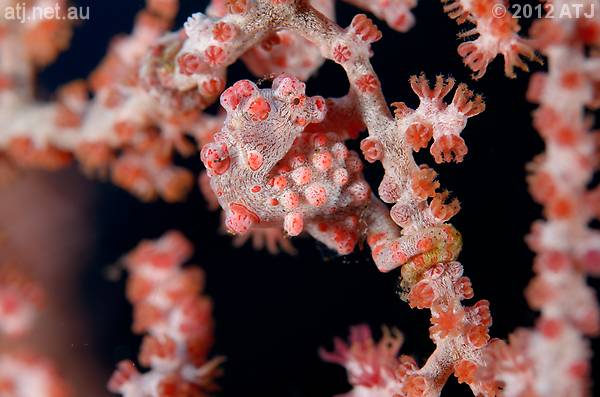
Pygmy seahorse, Hippocampus bargibanti, at The Estuary.
After lunch we sailed east and then south around the island to the site for the third dive, Hot Rocks. Another dive on the black sands but this time there was more evidence of volcanic activity with areas of bubbles coming out of the sand. A lot more nudibranchs on this dive as well as a juvenile emperor angelfish. Dive details

Juvenile emperor angelfish, Pomacanthus imperator, at Hot Rocks.
After the dive we sailed south-east to Gili Banta for the night dive. The dive site is called Circus because there is so many weird things to see. The site itself was mostly white sand and we traversed back and forth across the sand slope getting shallower with each transect. The site lived up to its name and we saw a lot of interesting animals, including a mimic octopus. Dive details

Black-finned snake eel, Ophichthus melanochir, at Circus.
After dinner we sailed for 90 minutes to the north-west corner of Komodo Island.
The first dive of the day was at Coral Garden. As the name suggests it was like a garden of coral. This was a fairly easy drift dive mostly on a flat deep sand area with coral bommies and ending up a reef slope in shallower water. Early in the dive Nicole and Sheree were lucky enough to see a manta ray that no-one else saw. Sheree got some video of it to prove the fact that the saw it. Dive details
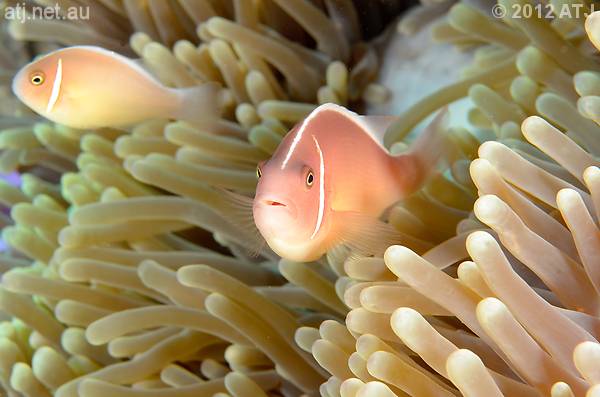
Pink anemonefish, Amphiprion perideraion, at Coral Garden
We had breakfast and then sailed to Gili Lawa Laut and Gili Lawa Darat. These are two small islands off the north-east tip of Komodo Island. The second dive of the day was a site called Crystal Rock off the northern side of Gili Lawa Laut. The current was pretty strong on this dive and for the first part of the dive we hung on a wall and watch the life swim by. After letting go from the wall we swam around the reef flat where we found a small banded sea snake. Dive details

Sea snake at Crystal Rock.
The third dive was at near Crystal Rock at a sight called Castle Rock. There was also a bit of current here but this time we drifted with it and moved along the reef slope. The highlights (for me) of this dive were two ribbon eels, one female, one male, in different locations. Dive details

Giant barrel sponge, Xestospongia testudinaria, at Castle Rock.
The sunset dive was along the beach on the western side of Gili Lawa Laut at a site called Shotgun Reef. We'd learn the next day the significance of the name Shotgun. This was an easy drift dive along the reef, starting while the sun was still up and finishing after sunset. Dive details

Sea fan at Shotgun Reef.
The first dive of Day 4 was at a site called Shotgun. Basically the dive is in a shallow channel between Gili Lawa Laut and Gili Lawa Darat. The channel is around 10 metres deep and between the tides the current through the channel can be quite strong. The plan for this dive was to ride the channel from one end to the other. After getting ready in the deep water at the start of the channel we swam into the current and were picked up and dragged along. It was quite exhilarating. At the end of the ride we pottered around the reef. A few people saw a couple of manta rays. Dive details

False clown anemonefish, Amphiprion ocellaris, at Shotgun.
Following breakfast we sailed to an area to the east from Komodo Island known as Current City. As the name suggests there are a lot of currents and most can be seen on the surface from the boat.
Our first dive at Current City was at a site called Tatawa Kecil. I don't know what Tatawa means in Indonesia but Kecil means "small", so it is a small something. The reef itself was around a small island (more like a rock sticking out of the sea) and was itself gorgeous with life everywhere. It was Julie's 100th dive ever. Dive details
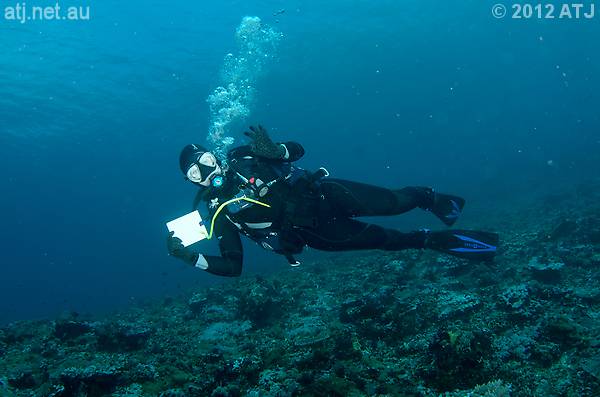
Julie at Tatawa Kecil on her 100th dive.
A short sail west across Current City and we were ready for the next dive of the day at Makassar Reef. This was a very long drift dive with quite a strong current. It was difficult to stop and even harder to go back the other way. We saw a very large cow-tail ray out on the sand. Dive details
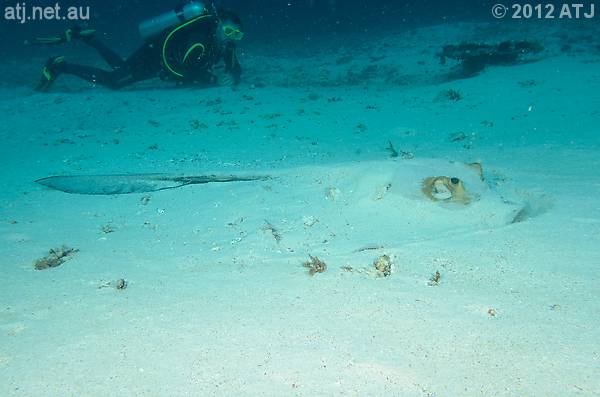
Cowtail ray, Pastinachus sephen, at Makassar Reef. Peter is in the background for scale.
We then had an 80 minute sail from Current City to Rinca Island for the sunset dive at Dragon Besar, The site was a beach on the northern side of a small island close to the top centre of Rinca Island. While Besar means "large" in Indonesian we were to see dragonets, small brightly coloured fish. The dive site itself was a shallow reef slope and as it was around sunset there were a lot of sea urchins about. In amongst the sea urchins were two species of dragonets: mandarinfish and picturesque dragonets, that were coming out to mate. They put on quite a show. Dive details

Mandarinfish, Synchiropus splendidus, at Dragon Besar.
The next morning we took a break from diving and went on a walk in Loh Buaya Dragon Park on Rinca Island to see komodo dragons up close. The dragons themselves are wild but were mostly lying around in the Sun. We had guides with us who had big sticks to hold back unruly dragons but they hardly even opened their eyes. It was great to see these legendary animals up close and in their natural habitat.

Komodo dragon, Varanus komodoensis at Loh Buaya.
We returned from the dragon walk and then had a 90 minute sail to Padar Island to the north east of Rinca Island. The 1st dive of the day was at Tiga Dara. This was three pinnacles with their bases in around 20 metres of water and the tops just below the surface. The plan was to swim around each of the pinnacles but the currents were very strong and variable and while we visited all 3, we really only swam around one of them. Dive details
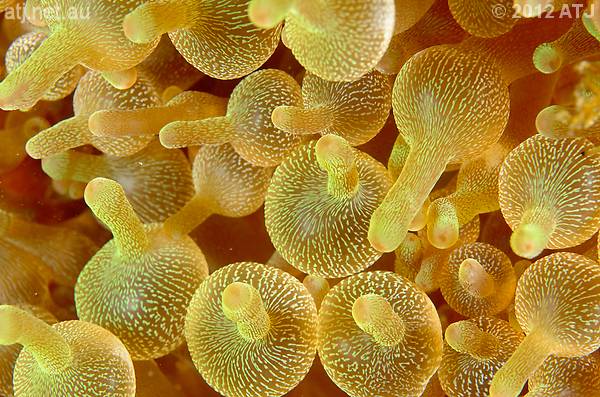
Bubble-tip anemone, Entacmaea quadricolor, at Tiga Dara.
It was nearly a 2 hour sail from Padar Island to Nusa Kode, an island just to the south of Rinca Island. Nusa Kode is fairly close to Rinca Island ad makes a nice protected harbour for us to moor close to the beach on Rinca Island. The next dive was at Cannibal Rock just off Rinca Island within the harbour just mentioned. Even though the water was quite cold, around 23°C, this was probably my favourite site of the trip and was full of life from tiny Coleman shrimp and zebra crabs living on fire urchins to a large anglerfish and even a bamboo shark and a blue spotted ray seen by some of the divers. There were lots of nudibranchs, too. Dive details

Giant anglerfish, Antennarius commersonii, at Cannibal Rock.
For the night dive we stayed in the harbour between Nusa Kode and Rinca Island and dived on the beach off Rinca Island at a site called Torpedo Alley. It gets its name from the tiny torpedo rays found there. Torpedo rays are a type of electric ray and the same family as numbrays. It appears that the torpedo ray found here is a undescribed species found only here or the surrounds. If Cannibal Rock was my favourite site, Torpedo Alley was a very close second. There was life everywhere and most of it bizarre. We saw crabs carrying upside-down jellyfish on their backs. Other crabs carrying sand dollars (a type of sea urchin). There were also tiny crabs, shrimp, nudibranchs, pleurobranchs and a cuttlefish. A most enjoyable dived. Dive details
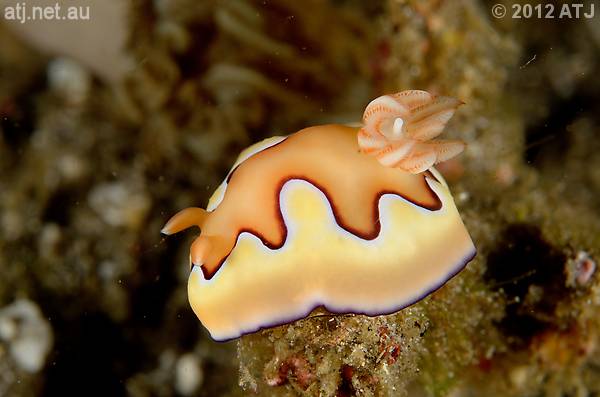
Nudibranch, Chromodoris coi, at Torpedo Alley.
We stayed in the harbour overnight and were up first thing for another dive at Cannibal Rock. The water was even colder for this dive (the coldest of the trip) but my mind was taken off the cold by all the cool things to see. This dive even had a hawksbill turtle. Dive details
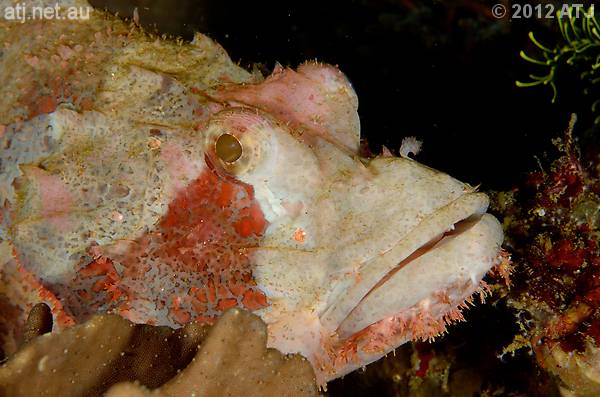
Bearded scorpionfish, Scorpaenopsis barbata, at Cannibal Rock.
After Cannibal Rock we had a two and a half hour sail to the next dive site on the south-western coast of Komodo Island. The site is called Manta Alley, although due to superstition we were encouraged not to use the full name for fear of jinxing our chances of seeing any mantas (a bit like "that Scottish play"). Well, we must have said it too many times because we didn't see any mantas at all. Despite the lack of mantas, it was an enjoyable dive with a number of hawksbill turtles being around, a huge bumphead parrotfish and a reef octopus that was out hunting for prey. Dive details

Day octopus, Octopus cyanea, at Manta Alley.
We sailed east and then north for a little over an hour from Manta Alley to a protected bay on the northern side of a peninsula off the south-eastern tip of Komodo Island. Here there was a nice beach and a dive site called Phinisi on the almost completely disintegrated wreck of a boat. Phinisi is actually a type of two masted Indonesia sailing boat (the Siren fleet is supposedly modelled on a phinisi) so I can only guess the wrecked boat was a phinisi. This was a nice easy dive in water much warmer than we'd experienced for the last few dives. Dive details
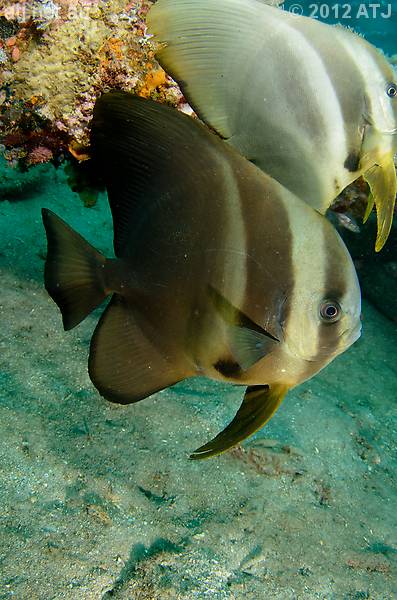
Long-finned batfish, Platax teira, at Phinisi.
A 90 minute sail got us to peninsula half way up the eastern side of Komodo Island for the night dive. The site was called Pink Beach which is something to do with the colour of the beach with the setting Sun. Another interesting night dive where saw 4 large Spanish dancer nudibranchs among the many nudibranchs seen, as well as a crocodilefish, mantis shrimp and a number of other interesting organisms. Dive details

Crocodilefish, Cymbacephalus beauforti, at Pink Beach.
Early on day 7 we sailed for an hour and a half north east back to Current City. The first dive of the day was at Batu Balong, a small pinnacle sticking out of the water in Current City. We did one full circuit of the pinnacle in an anti-clockwise direction and on the way saw turtles, moray eels, white-tip reef sharks, giant trevally, angelfish, nudibranchs and much more. This was an enjoyable dive. Dive details

Hawksbill turtle, Erectmochelys imbricata, at Batu Balong.
A 40 minute sail took us to Tatawa Besar, the site for the second dive. "Besar" means "large". The current was fairly strong at the start of the dive and we drifted rapidly along the reef. As we got further and shallower the current all but stopped. We saw turtles, angelfish, clown triggerfish, anemonefish and other interesting organisms. Dive details
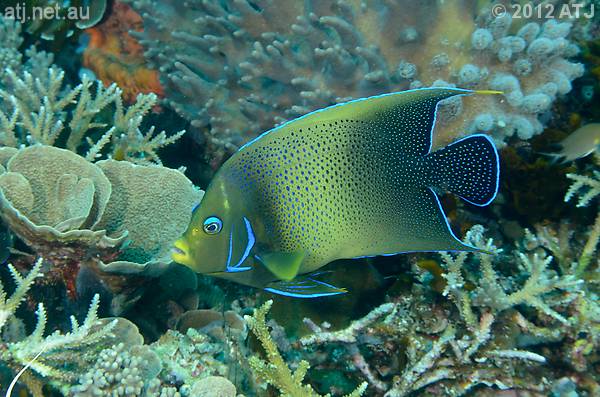
Half-circle angelfish, Pomacanthus semicirculatus, at Tatawa Bessar.
We sailed east for just under an hour and ended up back at Makassar Reef where we had previously dived on day 4. We were in a slightly different location from the previous dive at this site and rode a fast current over a reef flat. Dive details

Green turtle, Chelonia mydas, at Makassar Reef.
There was no sunset or night dive on day 7 and instead we sailed to a bay on north-eastern edge of Komodo Island close to Gili Lawa Darat. The dinghies took us to Gili Lawa Darat for a sunset walk, climbing a small mountain which overlooked the channel between Gili Lawa Laut and Gili Lawa Darat - the site we knew as Shotgun. It was a pleasant walk, although the climb up the mountain was very steep.

Gili Lawa Laut as seen from Gili Lawa Darut.
Our first dive of the morning saw us return to Crystal Rock where we had dived on Day 3. This time the visibility seemed to be more than 25 metres and there was little current. We covered a lot of ground on that dive and saw a lot, including a white-tipped reef shark. Dive details

Majestic angelfish, Pomacanthus navarcus, at Crystal Rock.
The second dive was another ride on the current at Shotgun. This time the current was slack and it was more like a popgun than shotgun. It was still an enjoyable dive even if we had to do a bit of swimming. Dive details

Red firefish, Nemateleotris magnifica, at Shotgun.
For the afternoon dive we went back to Castle Rock. We spent the first part of the dive stationary watching the reef go about its life around us, including a number of white-tipped reef sharks. We also saw another female ribbon eel. Dive details
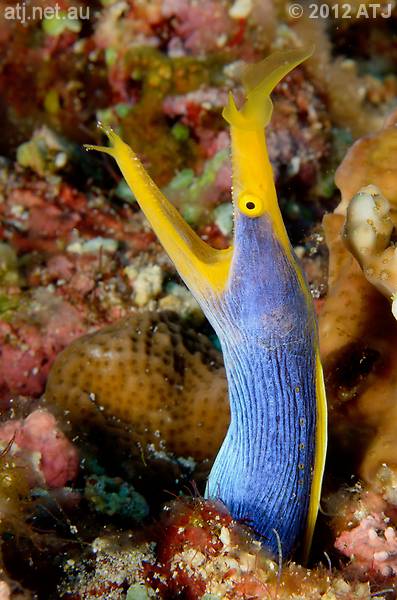
Ribbon eel, Rhinomuraena quaesita, at Castle Rock.
After a 90 minute sail to Komodo Island we did the sunset/night dive at Coral Garden (same location as the morning dive on Day 3). This was a relaxing dive drifting with the current down the reef although we didn't see anything particularly exciting. Dive details
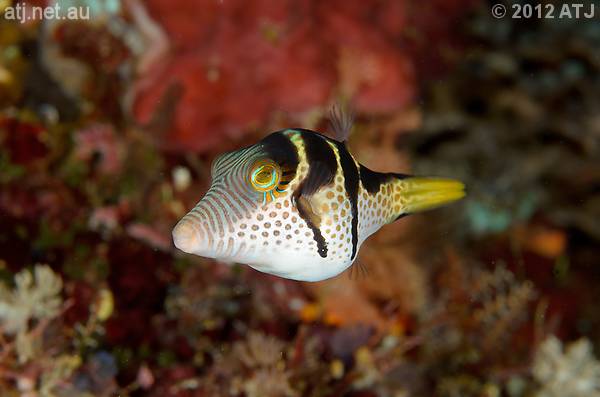
Saddled pufferfish, Canthigaster valentini, at Coral Garden.
Early in the morning we sailed to Gili Banta for our second last day of diving.
The first dive was at K2. I really enjoyed this dive because I not only saw a broadclub cuttlefish but also a manta ray swam passed quite close near the end of the dive. Dive details
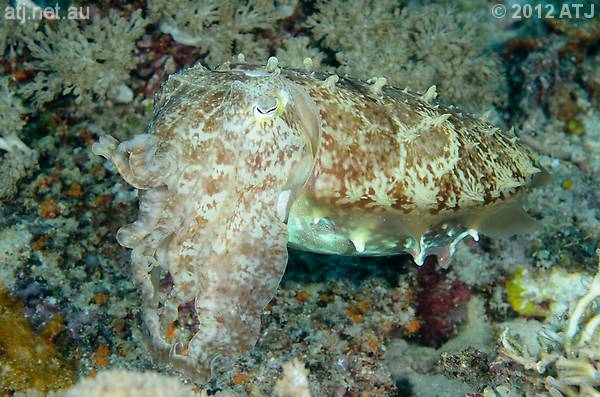
Broadclub cuttlefish, Sepia latimanus, at K2.
Manta Ray, Manta alfredi, at K2.
We had an hour or so sail around Gili Banta for the second dive at a site called Swiss Dream. This was a similar dive to K2 and when we got to the reef flat we were rewarded with one or two mantas. The mantas also hung around after we got back to the boat and we saw them playing on the surface. Dive details
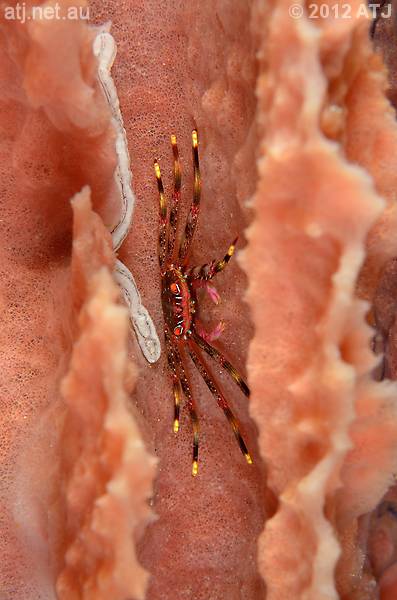
Flat rock crab, Percnon planissimum, at Swiss Dream.
A 90 minute sail took us from Gili Banta to Sangeang Island, the volcanic island from Day 2. For the afternoon dive we went to Bonto Reef. Like the other Sangeang Island dives this was on the black volcanic sand. It was a bit of a muck dive with a lot of small animals such as nudibranchs. Dive details
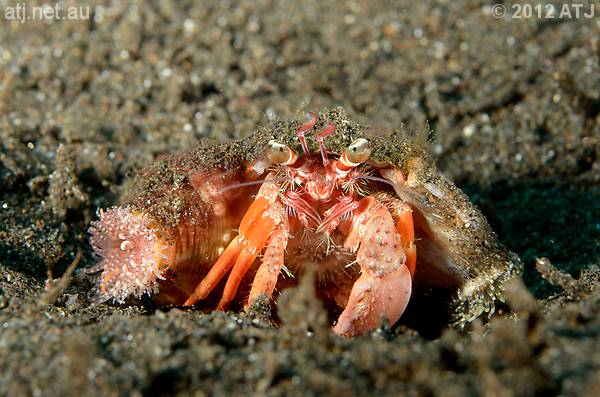
Hermit crab, Dardanus pedunculatus, at Bonto Reef.
After the third dive the crew hoisted the sails so we could have an opportunity to take some photographs of the Pa Siren in full sail. Even though the sails are more for show than functional, the boat still looked great as it was sailing off Sangeang Island. Once the sails were brought down we motored back into Bima Bay for a barbecue on our second last night on the boat.
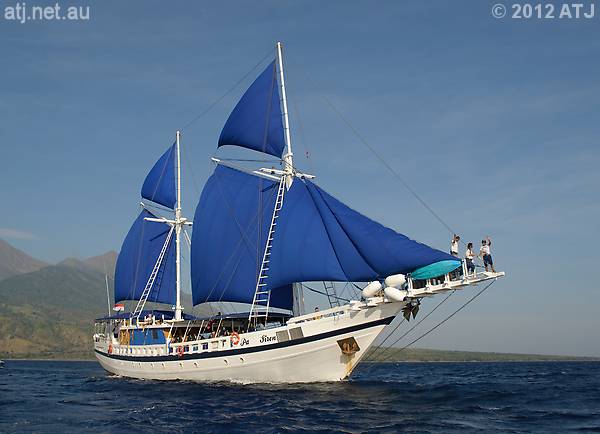
Pa Siren off Sangeang Island.
The first dive of the day was a muck dive at Nudibranch Reef. Given the name of the site we were not at all surprised to see a lot of nudibranchs. There were a number of other interesting creatures which made this an enjoyable dive. Dive details
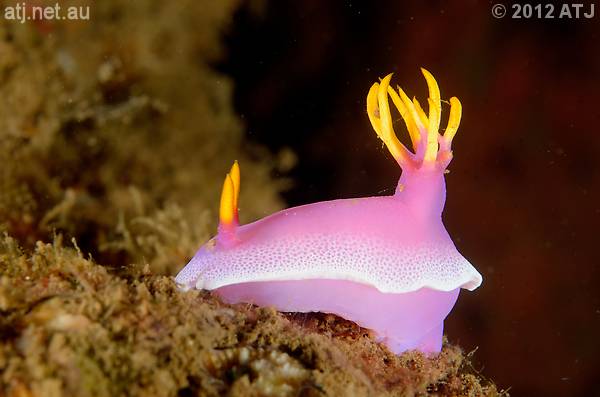
Nudibranch, Hypselodoris apolegma, at Nudibranch Reef.
The final dive of the trip was at the same site as the first dive of the trip, Unusual Suspects. I'm not sure if we dived at a different location at the site but it looked completely different and I saw ay more on this dive than the first dive. Like Nudibranch Reef, there were a lot of nudibranchs, but we also saw 3 seahorses, a number of pipefish, crocodilefish, and some saw some anglerfish ("frogfish"). As this was our last dive of the trip we could stay for as long as we liked. I managed 98 minutes and would have liked to have stayed longer but I was running very low on air. Dive details

Thorny seahorse, Hippocampus histrix, at Unusual Suspects.
It was then time to wash our gear and start packing up ready to leave the boat the next morning. That evening we sailed the last 30 minutes to Bima where we stayed the night to off-gas before our flights the next day.
It was a fantastic trip with no complaints. The boat was great. The crew were wonderful. The diving was sensational. I can highly recommend a trip on a Siren fleet boat.
Last updated: 12 January 2013